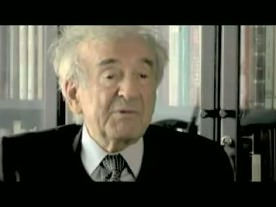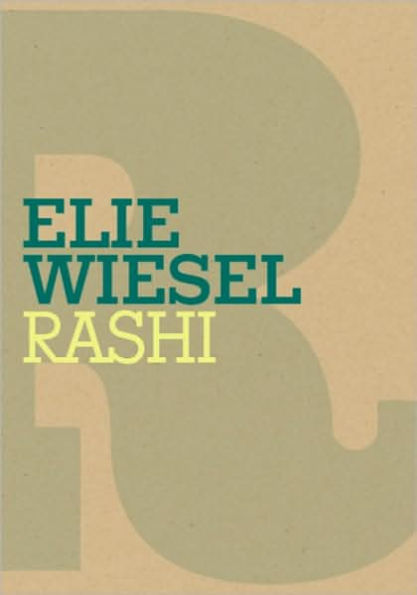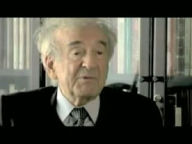

eBook
Related collections and offers
Overview
Wiesel brilliantly evokes the world of medieval European Jewry, a world of profound scholars and closed communities ravaged by outbursts of anti-Semitism and decimated by the Crusades. The incomparable scholar Rashi, whose phrase-by-phrase explication of the oral law has been included in every printing of the Talmud since the fifteenth century, was also a spiritual and religious leader: His perspective, encompassing both the mundane and the profound, is timeless.
Wiesel’s Rashi is a heartbroken witness to the suffering of his people, and through his responses to major religious questions of the day we see still another side of this greatest of all interpreters of the sacred writings.
Both beginners and advanced students of the Bible rely on Rashi’s groundbreaking commentary for simple text explanations and Midrashic interpretations. Wiesel, a descendant of Rashi, proves an incomparable guide who enables us to appreciate both the lucidity of Rashi’s writings and the milieu in which they were formed.
From the Hardcover edition.

Product Details
| ISBN-13: | 9780307378675 |
|---|---|
| Publisher: | Knopf Doubleday Publishing Group |
| Publication date: | 08/11/2009 |
| Series: | Jewish Encounters Series |
| Sold by: | Random House |
| Format: | eBook |
| Pages: | 224 |
| File size: | 2 MB |
About the Author

From the Hardcover edition.
Hometown:
New York, New YorkDate of Birth:
September 30, 1928Place of Birth:
Sighet, RomaniaEducation:
La SorbonneRead an Excerpt
Chapter 1
Impressions
I stroll around the new and old streets of the city of Troyes, in Champagne. It still vibrates with medieval history. I am shown the Hôtel-Dieu at the corner of the rue de la Cité and the quai des Comptes: this is where the Porte de la Juiverie, the old gateway to the Jewish neighborhood, was located. And what about the fairs where the Jews from the nearby cities met to discuss business and the rules of ritual? As always, these are to be found in books.
Cited by Irving Agus and again by Gérard Nahon, the Hebraic name of Troyes (or Troyias) first appears in a document written by Yosef bar Shmuel Tov-elem of Limoges in the eleventh century: “Concerning our brothers in Rheims who used to go to the fair in Troyes and whom an enemy lord captured (or persecuted).”
Who were these Jews? What enemy is he referring to? We know there used to be a synagogue here (there is even a street named after it), and there used to be a street of the Jews, a rue des Juifs (now gone as well). There were rabbis, hence students. There were leaders, Jewish families loyal to the Law of Moses, who fought against the outside enemy and the poverty in their midst, helped the poor, and did everything they could to pay the ransom and free their co- religionists when they were taken as hostages. In spite of distances, there were deep contacts between the communities: their right to intervene in one another’s affairs was recognized by the competent rabbinical authorities. After all, didn’t they share a common destiny?
As for me, today, I am looking for the traces of a man whose learning still influences my life, as it does the lives of all those who have a thirst for study.
Houses, large and small, stores, gardens. The man I am looking for must have walked here, dreamed here, shed tears here over the destruction of the Temple in Jerusalem, comforted broken hearts, counseled those who had gone astray, taught them to overcome fear and hope for the arrival of the Messiah.
I remember: as a child, his cursive script frightened me; more than that of the Bible, it suggested a world that was doubtless complex and probably mysterious, where only adults had the right and competence to enter.
Later, with the years, in the heder or yeshiva, before the candles on the table, every time someone asked, “What does Rashi say?” I rushed to look at his countless commentaries. Whenever I couldn’t grasp the meaning of a word, it was he, the Teacher of my Teachers, who rescued me. An intimate relationship, from child to elderly man, person to person. He said to me, as if confidentially: look, my child; fear nothing, everything must be grasped and conveyed with simplicity. Strange words stand in the way like obstacles? Start all
over again with me. It happened to me too. I started all over again. You just have to break through the shell of a word, a sentence, an expression. Everything is inside them. Everything is waiting for you.
Thanks to his life, his erudition, his work, his generosity, he remains the spring from which we all drink. Without him, my thirst would never have been quenched. Without him, I would have gone astray more than once in the gigantic labyrinth that is the Babylonian Talmud.
Yet he doesn’t try to impress us with his learning, his vast religious and secular culture, his originality, or even his inventive mind. He confines himself to quoting the ancients or his precursors, sometimes his peers, and even his own disciples.
Rashi or the celebration of commentary? Better yet: Rashi or the celebration of memory, and of fraternity too. The danger lies in oblivion. Were I to forget where I come from, my life would become barren and sterile. Were I to forget whom I am the descendant of, I would be doomed to despair.
I loved him. I couldn’t make headway without him. Of course, I explored other approaches, other commentaries: those of Abrabanel, Sforno, Radak, Or ha-Hayim, Ibn Ezra, but Rashi’s are unique, different, indispensable. He radiates warmth and friendship. And simplicity. He is great because he remains faithful to the text, and to its literal meaning. He never uses his learning to make things complicated but to simplify. He never flaunts his erudition to impress students with the originality of his reasoning. Reconciling two words, two sentences, two verses is enough for him. To those who are timid he seems to be saying, Don’t be afraid, I am here by your side.
Sometimes, in my small town, it seemed to me that Rashi had been sent to earth primarily to help Jewish children overcome loneliness.
And fear.
Under a cloudless blue sky, alone with my thoughts, and my nostalgia, I wander through the back streets of Troyes.
Where was his house? No one can tell me. His vineyard? Again, no one knows. His grave in the Jewish cemetery? His parents’ graves or his wife’s? The graves of his three daughters? Are there any remains of his house or his school?
I find none.
I try to use my imagination.
The father and his three daughters during the grape harvest. Their Sabbath dinners. The discussions with his students. His solitude as he bent over his worktable, consulting books and ancient documents, and writing his oeuvre whose immensity never ceases to surprise us— his commentary on the Bible and the Talmud, and his vast body of responsa,
the answers he furnished to questions posed from faraway rabbis.
Yes, we need imagination in order to write about him.
In those days, the Jewish communities in the provinces along the Rhine lived between fear and hope. At times the former dominated as though attracted by unfathomable gloom, at times the latter, making the dawning sun shine bright.
Often bound to one another through religious study and commerce, they flourished at the whim or self-interest of the church authorities and political sovereigns.
At the center of the Talmudic schools, the last in the Gaonic period, was Rabbenu, our Teacher, Gershom, Meor ha-Golah, the Light of the Exile, the uncontested leader of Jewish life. In dealing with complicated questions concerning the interpretation of the Law and doubts about matters of faith, it was to him that they flocked from all over the Diaspora.
We think he died in 1040, but we’re not absolutely positive. We like to think this because that was the year of Rabbi Shlomo’s birth—Rabbi Shlomo, son of Yitzhak, known by his initials, Rashi. According to Rabbi Shlomo Luria, this coincidence proves the validity of the verse in Ecclesiastes, “The sun also arises, and the sun goeth down”: in the world of men, as soon as a spiritual sun sets, another rises. It is simple: humanity could not survive, not even temporarily, in darkness.
Actually, other more reliable sources refer to 1028 as the date of the Gaon’s death. Let us leave it up to medieval historians to decide. On the other hand, most agree on the date of Rashi’s birth, 1040, and all on the date of his death, 1105.
At the time, the Jews in France lived more or less normal lives, depending on the disposition of the Church, and the mood and interest of the Capetian kings Hugh, Henry I, Philip I, Louis VI, and Louis VII. When the Jews were needed, they were left in peace. Afterward, they were disposed of.
In France, the Jewish communities considered themselves well established because they dated from ancient times. They were already there in Roman times, at first in certain specific areas, particularly near the Mediterranean coast. A rue des Juifs could be found everywhere and, in some cities, can still be found today: the stones are a testament to
history.
Did the first Jews arrive as war prisoners with the victorious Roman legions? So it is believed. They wound up in ancient settlements like Marseilles and Narbonne. They were found scattered in other places—in Paris, Avignon, Orléans, Metz. Protected by Roman law, they survived thanks to trade in wines and spices, travel, and what was called usury.
With the accession of the kings of Gaul, things changed. The Jews were no longer “citizens.” During the sinister apocalyptic mood that prevailed around the year 1000—further inflamed by the appearance of a fiery comet in 1014 and the solar eclipse in 1033—they were unprotected. They were not even tolerated. They were singled out, here and there, and accused of causing the scourges that befell superstitious inhabitants. Forced conversions, arbitrary arrests, threats of expulsion; it seemed these invariably followed the same logic of a cruel implacable destiny. Occasionally, with a bit of luck and a lot of money, the ruler or bishop deigned to change his mind and a reprieve was granted.
The year 1017: King Robert the Pious orders the Jews to convert; when they refuse, he sets fire to synagogues and Jewish homes. In the same period, in Limoges, the Jews, loyal to their ancestral faith, are expelled. A contemporary chronicler, Adhémar de Chabanne, writes: “There were some among them who slit their own throats with their swords rather than accept baptism.” In November 1012, the Jews were expelled from Mainz; in January 1013, they were back. Sometimes the Vatican itself was persuaded to intervene. Then, in 1095, in Clermont, the bloody, deadly explosion took place: Pope Urban II preached in favor of the Crusade. Destination: Palestine. The goal: to save Christianity’s holy sites. Along the road, says one witness, in Rouen, the Crusaders locked the Jews in a church and ordered them to convert, then massacred them with two-edged swords, men, women, and children. Moreover, Godfrey of Bouillon declared publicly that he “wouldn’t set off except if he had avenged the blood of the crucified in the blood of Israel and not let a single person with a Jewish name survive.”
These atrocities, and others, were committed wherever the Crusaders of Christendom made their appearance, including in the province of Champagne, not far from Troyes.
Here and there, living in fear of the next day, the Jewish communities that were directly concerned sent messengers to their neighboring communities warning them of the imminent danger.
In most cases, they did so in vain.
However, in the area of education and culture, the situation of the Jews seems rather enviable. There was a Jewish religious culture in France well before Rashi. Several centers were well known for the distinction of their teachers. Indeed this was the period in the history of European cultural and religious thought that saw the birth of Jewish learning in France. So that as a youth Rashi knew where to go to complete his biblical and Talmudic studies. Many scholars came from Italy and settled in the Rhineland and France. Mainz, Speyer, Vitry, Worms, and Limoges attracted the best students. Among them, Shlomo, son of Yitzhak.
Who was this father? We know very little about him. Some believe he was a very erudite man. It is thought that Rashi himself asserts it. He does so by paying him a great compliment, which is this:
His impressive commentary of the Bible starts with a question asked by a Rabbi Yitzhak: why does the Bible begin with the description of the genesis of the world rather than with the first law, which concerns the calendar? We will return to this question. For the time being, let us just recall that for some exegetes, this Rabbi Yitzhak is none other than the author’s father.
If this assumption is correct, it would mean that we know at least one thing about Rashi’s father: he was himself a rabbi who posed questions worthy of contemplation. But beyond the fact that he was the father of one the greatest scholars of the biblical and Talmudic literature, we know very little.
Nothing more? No, not much more. We’re not even sure of the basic facts of his biography. Did he have other children, a brother perhaps (just one?), who was also a talmid hakham, a Talmudic scholar? How old was he when he died? Was he a martyr? One source intimates as much by calling him kadosh, or holy, but can’t this term also describe a moral life devoted to the Lord? How old was Rashi when he became an orphan? In one place, Rashi quotes him and calls his father “Avi mori,” my father and my teacher. Does this mean he studied the Torah with him and maybe also the Babylonian Talmud? Rabbi Haim David Azulai writes that he was a true Talmudist.
Strange: we know so many things about so many individuals thanks to Rashi, and so little about the man who gave him life. And even less about his mother.
Why Rashi? The intials of Rabbi Shlomo Yitzhaki, Shlomo son of Itzhak, or, just as simply, Rabbi Shlomo she-yihyheh (may he have a long life)? The illustrious Rabbi Hayim ben Attar has his own interpretation: the name comes from the initial letters in Rabban Shel Israel, Teacher of all Israel. Rabbi Nahman of Bratzlav calls him “the brother of the Torah.” The Torah and his commentary are inseparable. But the title that suits him best is simply “ha-Moreh ha- Gadol,” the Great Teacher.
We don’t know the precise date of his birth in 1040—or perhaps 1041. On the other hand, his date of death in 1105 is well established: the twenty-ninth day of the month of Tammuz, hence a Thursday in the middle of the summer. This date can be seen on the Parma de Rossi parchment written by one of his disciples and transcribed in 1305: “the holy ark, the holiest of holiest, the great Teacher Rabbenu Shlomo blessed in memory as righteous, son of the martyr Rabbi Yitzhak the Frenchman, was taken from us on Thursday, the twenty- ninth day of the month of Tammuz in the year 4865, aged sixty-five, and called back to the yeshiva above.”
That’s very scanty biographical information, is it not?
In Rashi’s day, about a hundred Jewish families lived in the beautiful city of Troyes. They lived modestly and experienced no great upheavals. These occurred only in the thirteenth century. In 1288, to be exact.
It was the old story of ritual murder—stupid, ridiculous, but oh so deadly. It is mentioned in The Lamentation of Troyes by Yaakov ben Yehuda of Lorraine. Hate-filled fanatics put the corpse of a Christian child in the house of a Jewish notable, Isaac Chatelain. Arrested along with his whole family, interrogated, they all suffered the abuse and torture that was usual at the time. They all chose Kiddush ha-Shem, a martyr’s death, the supreme sacrifice in the sanctification of God’s name.
Dark times spawn legends of hope, dreams of a hero, which for Jews in those times meant not a soldier but a scholar, an interpreter of God’s word. Several legends surround Rashi’s birth. They say his parents owned a precious gem that was so luminous and sparkled so brilliantly that the Church dearly wished to acquire it for ritual use. They were offered astronomical sums and substantial benefits. Fearing both the possible temptation and the probable intimidation, they took the gem and threw it into the sea. Heaven rewarded them by giving them a son whose beneficial light was more exceptional and dazzling than that of the precious gem.
Related Subjects
Videos


